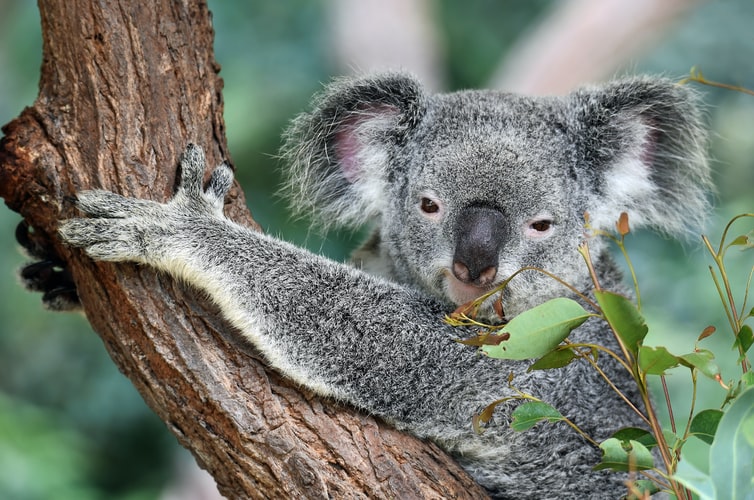Sloth – the slowest animal in the world
They call themselves that for a reason, they live in slow motion. They are just lazy and apathetic. They make their every move very slowly.
What do sloths eat?
Sloths are herbivores. They mainly eat leaves, shoots, flowers, and fruit. Their stomach is multi-chambered and contains bacteria that feed on cellulose. The process of digesting food can take up to a month.
Threatened with extinction
These animals are threatened with extinction. This is due to the continuous logging of Brazilian equatorial forests. Not surprisingly, they reproduce quite slowly. The slow evolutionary pace, which prevents them from adapting to new environments, also has a negative impact. An additional threat is the Indians living in South America, who hunt these animals to obtain meat.
Sloth speed
As mentioned before, these mammals are quite slow. They much prefer to walk through trees. Although they are good climbers, it takes about 10 minutes for them to climb a tree that is 16 meters high. They mostly crawl on the ground at a speed of 7 meters per minute.
Species of sloths
We divide sloths into two families: sloths (Megalonychidae) and sloths (Bradypodidae). The lazybones include two modern species, the characteristic feature of which are the front paws ending with two fingers. In the family of sloths, in turn, today we can find four species, and each of them has three fingers on its forelimbs. There are two species of these animals – three-toed sloths and two-toed sloths. As the name suggests, the main feature that distinguishes them is the number of fingers.
*Fun Facts about Sloths*
- They spend most of their lives hanging upside down under the branches of trees.
- Sloths lead a solitary lifestyle and do not live in herds. The exception is the female that gave birth to the young. Sloths do not have their nest, therefore the little ones stay at their mother’s breast for several months.
- The body temperature of these mammals ranges from 74 to 92 degrees Fahrenheit (30 to 34 degrees Celsius).
- Most mammals regulate their body temperature by changing their metabolic rate. However, sloths do this by going from sun to shadow. As a result, their caloric needs are much lower compared to other mammals of similar size.

- Sloths are found exclusively in the tropical forests of Central and South America.
- The ancestors of sloths were of impressive size. The largest was Megatherium americanum, a species of the size of an elephant.
- Compared to other animals of similar size, they have about half the metabolism. It is he who contributes to the surprisingly low, for mammals, body temperature of sloths, which, in addition, is not regulated by themselves. Their body temperature is regulated, among other things, by the transition from the sun to the shaded area.
- Apart from the front legs and neck, they have a low body. It is thanks to their low muscle mass that they are so light in relation to their weight. It also contributes to the fact that they cannot shiver from the cold to warm themselves up a bit.
- These animals are resistant to all kinds of infections. Deep wounds very rarely turn into serious infections.
- In the Pleistocene, terrestrial fossil sloths lived. Their existence was discovered in 1789 in Brazil. As scientists have managed to determine, they became extinct quite recently – about 10 thousand years ago. The largest specimens reached the size of an elephant.
- They feel good not only in trees but also in water. They can swim perfectly. This is an extremely important ability during periodic river floods in South America.
- They leave the trees very rarely, mainly when needed. They feel it once a week.
- Interesting facts about sloths – they crawl on the ground. They are extremely slow animals, but they move much faster in water.
- Their sense of sight and hearing is extremely poor. Not surprisingly, they also have poor reflexes.
- Three-toed sloths have tails approximately 4 cm long.
- Sloths eat different parts of plants, from leaves to buds to twigs. From time to time they will also eat some fruit. A multi-chambered stomach and the bacteria in it help digest this nutrient-poor food.
- The diet of sloths can also be supplemented with … algae. Their private algae. Sloths are so slow that algae can develop on their hair, helping to mask themselves against green trees.
- Sloths spend most of their lives hanging from branches, as we do when we are children. This position is so natural for sloths that their internal organs are arranged differently from other mammals. All this to make the body of sloths work as it should.
- The hair of these animals grows from the belly to the back.
- They have 9 cervical vertebrae (most mammals have 7). Thanks to the additional vertebrae, they can turn their head 180 degrees.
- They live on average 15 years in the wild. Some individuals live up to 30 years in captivity.
- On a lazy day, they only walk a few meters.
- The structure of these mammals is adapted to hang head down on a tree or to lie down. This is their favorite position where they sleep, eat and copulate.
- They spend 10 to 15 hours a day sleeping.
- Contrary to appearances, sloths are great swimmers. They can also cope with diving – they can hold their breath for up to 40 minutes!
- Sloths lead a solitary lifestyle. They meet only during the mating season. Only the female and the young stay together until the toddler becomes independent.

- There is a reason why they like living in trees. It is a shelter from predators for them. Additionally, as I mentioned before, their fur is covered with algae, which helps sloths to mask themselves from aggressors.
- Gestation in these animals takes about a year. The female gives birth to young in the treetops.
- Insects, and parasites live in the hair of sloths.
- Underwater they can withstand up to 40 minutes with one breath.
- Young people become independent after about a year. Then he leaves his mother and does not maintain contact with her.
- However, they are not so free in everything. Sloths value privacy very much. A love encounter between two individuals can last as little as 10 seconds.

- They move 3 times faster when swimming in water than when crawling on the ground.
- The natural enemies of these mammals are eagles, snakes, and jaguars.








